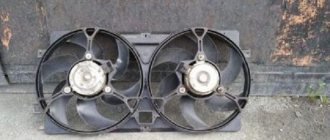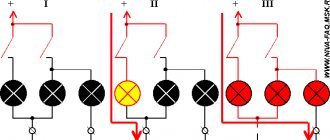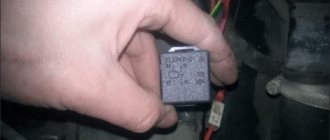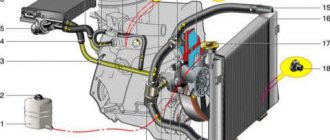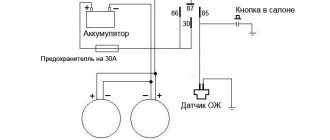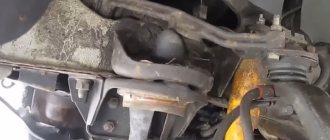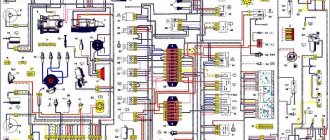To maintain the optimal temperature in the engine, a cooling system is installed in the car. One of the main elements in this system are fans, thanks to which the required amount of air is supplied to the engine through the radiator core. If it stops working, the Niva Chevrolet cooling fan overheats as excess heat begins to accumulate. Unlike classic cars, it has two fans, making the functioning of the systems much more complicated. If the arrow that shows the temperature is in the red area, and the cooling system refuses to work, and at the same time the cooling fan does not turn on, then the car should be taken to a car service center as quickly as possible, or you should try to find the cause of the malfunction yourself.
Causes of malfunction
The first thing you should pay attention to when the system is not working is the state of the fuses, which are located under the front panel, on the passenger side, in a special mounting block. A pair of fuses are responsible for the cooling operation; if the right one fails, then both fans stop working, and if the left fuse blows, then one element can continue to operate.
In addition, the mounting block has three relays that are responsible for operating the fans at different speeds. And if the relay responsible for operation at low speeds burns out, then the cooling system works correctly only at high speeds, and at low speeds the engine begins to heat up. Power is supplied to the relay through a special fuse, which can also fail, causing system failure.
Failure of temperature sensors also affects proper cooling operation. They are located on the engine. They operate when the desired temperature is reached, one when it reaches 90 degrees, and the second when it reaches 101 degrees. It is recommended to start checking with them, this is done this way: the connector is disconnected from the electric motor, and power is supplied to them directly through the battery; if the electric motor is running, then the reason is in the sensors.
If after checking everything, fuses, relays and sensor are in order, you should pay attention to the fans.
Tips for motorists
The favorable thermal regime of the Chevrolet Niva SUV engine is supported by a cooling system, in which two serviceable fans play a significant role, providing the required air flow through the radiator core. If the fans fail, the cooling system cannot cope with removing excess heat from the engine, and it begins to overheat. Due to the fact that the number of fans on the Chevrolet Niva has been doubled, the electrical circuit for turning them on has become more complex than on conventional passenger cars.
If the temperature gauge needle is near the red part of its scale, and the system fans do not turn on, then you will have to stop and start searching for this malfunction. To do this, you will need to remove the cover of the additional mounting block located under the front panel (below the glove compartment) in the area where the front passenger's feet are located. There are two fuses protecting the electrical circuits of the fan motors. If the fuse protecting the circuit of the right electric motor blows, both fans will not turn on, and if the second blows, only the left fan .
Checking and removing fans
To understand whether they work or not, you need to disconnect the connector from their motors, and connect a lamp to the wires through which voltage is supplied; we do the same with the sensor; if both lamps light up, then the problem is in the fans.
To remove them you need to do the following:
- Disconnect all wires
- Removing the upper pipe
- Removing the bumper
- If there is an air conditioner, bend the tubes (this must be done carefully, as they may burst) or drain the freon (filling it back will not be cheap), then remove the air conditioner radiator.
- You need to loosen the nuts on the radiator casing
- Tilt the radiator so that you can remove the fan unit
- Unscrew the bolts that secure the block and remove it
After removal, it is recommended to immediately replace both with new ones, since there is a possibility that a little time will pass and the second element will fail and all replacement work will need to be done again. You can do this procedure from below, but you will need special equipment, and you will need to move the engine ten centimeters back, which is very labor-intensive.
Fans of the Niva Chevrolet cooling system are used for forced ventilation of the radiator. They increase the intensity of heat dissipation while driving at low speeds and are the only way to cool the antifreeze in a plug or “toffee”.
Rules for operating a car if a problem takes you by surprise
If the cooling fans stop working, then you need to follow some rules to prevent the engine from overheating:
- Enable forced operation of the fan from the battery. If this does not help, go to step 2.
- Limit your driving speed to 60 km/h and try to maintain this speed constant. This will allow you to cool the antifreeze without a radiator.
- If possible, resort to heating the interior, this will remove some of the heat from the coolant.
- If possible, stop while driving; this will also remove heat from the antifreeze.
Design and principle of operation
The designers of the Chevrolet Niva used a dual fan unit in the cooling system. This slightly complicated the connection diagram, but sharply increased the efficiency of radiator airflow. The fans are driven by 12-volt DC synchronous motors with a permanent magnet inductor. Electric motors have a closed, non-demountable design and do not require maintenance.
The power of each electric motor is 110 W. The fan assembly draws 18 amps.
The fans are turned on one by one using an electromagnetic relay controlled by the on-board computer. When the coolant heats up above 99 degrees, the electric fan located closer to the engine air intake starts. The switch-on temperature of the second impeller is 101 degrees. The fan connection diagram is shown below.
The fan power system includes three relays and a resistor, which, if necessary, provides a reduced rotation speed of the first motor. Power is supplied from the battery through fuses that save the wiring and battery in the event of a short circuit. Control signals come from pins 29 and 68 of the motor controller.
The fans automatically turn off when the antifreeze cools to 95 degrees.
Consecutive switching on and off of engines reduces the load on the on-board electrical network. In most cases, it is possible to normalize the temperature only with the help of the first fan. This is especially useful when driving at night, when headlights and side lights put a lot of stress on the generator.
Circuit breakers
The electrical circuits of Niva Chevrolet cars produced before and after 2009 are different. In both cases, 50-amp fuses protecting the electric fan power circuits are located in an additional unit. It is located behind the glove box on the passenger side of the cabin. The figure shows where the fan fuses are located.
If the permissible current is exceeded, the insert melts and the circuit opens. Therefore, fuses are the first thing to check if the electric cooling fan does not work. The performance of a part can be assessed visually or using an ohmmeter (multimeter). To do this, you will first have to remove the fuse from the socket.
Last messages
Where are the fan relays on the Chevrolet Niva? To answer this question, it is worth noting that there are two cooling devices on the Chevrolet Niva, so the corresponding relay is responsible for the operation of each. So, having discovered a malfunction in the car’s cooling system, it is worth paying attention to the suitability of the relay.
But first they must be removed from the installation site. To do this, you need to open the right front door of the Shevik and look from underneath at the dashboard. It is there, under the cover of the mounting block, that the fan and fuel pump control relays, as well as the fuses for these devices, are located.
In the photo below you can see where the control switches are located: To remove the device from its seat, you need to pull it out of the installed socket. To do this, grab the product with one hand and pull. After removing it, do not rush to buy a new relay, as the problem may lie elsewhere.
To do this, it is worth checking its performance. Checking the functionality of the relay and replacing the device There are two ways to check: Swap the relays, provided that one of the fans is working.
Chevrolet Niva 2011, 80 l. With. - electrical and electronics
In this case, the fan should work; if not, then the cause of the malfunction should be found elsewhere. To replace the device, after checking it is necessary to include a working product in the circuit, preferably a new one. To install it, you simply need to check the correct location of the contacts, and in this position plug them into the receiving sockets.
Some Niva Chevrolet car models are equipped with a metal retaining plate.
Fan relay
The additional block contains not only fuses. There are also three electromagnetic relays that control the operation of the electric motors of the cooling system. Their control circuits are powered from the ignition switch and on-board controller outputs, and the power current comes from the battery through fuses.
The relay operates as follows:
- Voltage is applied to the control terminals.
- Current passes through the inductor, resulting in an electromagnetic field.
- The steel contacts attract and close.
- The current passing through the relay drives the electric motor.
As soon as the control voltage disappears, the contacts open under the influence of the spring and the fan stops.
You can check the functionality of the relay in three ways:
- Replace the relay with a known working one and test the operation of the system.
- With the engine off and the ignition on, disconnect the temperature sensor connector. You should hear the relay click.
- Dismantle and test the output contacts with a multimeter, applying voltage to the terminals of the induction coil.
Reasons why the cooling fan does not work on a Chevrolet Niva
To maintain the optimal temperature in the engine, a cooling system is installed in the car.
One of the main elements in this system are fans, thanks to which the required amount of air is supplied to the engine through the radiator core. If it stops working, the Niva Chevrolet cooling fan overheats as excess heat begins to accumulate. Unlike classic cars, it has two fans, making the functioning of the systems much more complicated. If the arrow that shows the temperature is in the red area, and the cooling system refuses to work, and at the same time the cooling fan does not turn on, then the car should be taken to a car service center as quickly as possible, or you should try to find the cause of the malfunction yourself.
Fans of the Niva Chevrolet cooling system are used for forced ventilation of the radiator. They increase the intensity of heat dissipation while driving at low speeds and are the only way to cool the antifreeze in a plug or “toffee”.
The electrical circuits of Niva Chevrolet cars produced before and after 2009 are different. In both cases, 50-amp fuses protecting the electric fan power circuits are located in an additional unit. It is located behind the glove box on the passenger side of the cabin. The figure shows where the fan fuses are located.
If the permissible current is exceeded, the insert melts and the circuit opens. Therefore, fuses are the first thing to check if the electric cooling fan does not work. The performance of a part can be assessed visually or using an ohmmeter (multimeter). To do this, you will first have to remove the fuse from the socket.
The additional block contains not only fuses. There are also three electromagnetic relays that control the operation of the electric motors of the cooling system. Their control circuits are powered from the ignition switch and on-board controller outputs, and the power current comes from the battery through fuses.
The relay operates as follows:
- Voltage is applied to the control terminals.
- Current passes through the inductor, resulting in an electromagnetic field.
- The steel contacts attract and close.
- The current passing through the relay drives the electric motor.
As soon as the control voltage disappears, the contacts open under the influence of the spring and the fan stops.
You can check the functionality of the relay in three ways:
- Replace the relay with a known working one and test the operation of the system.
- With the engine off and the ignition on, disconnect the temperature sensor connector. You should hear the relay click.
- Dismantle and test the output contacts with a multimeter, applying voltage to the terminals of the induction coil.
The control unit receives information about the antifreeze temperature from a temperature sensor. It is a resistor whose resistance changes with heating and cooling: from 1.3-1.8 kOhm at 30℃ to 155-196 Ohm at 90℃. You can check its performance using an ohmmeter and a thermometer. To do this, you need to remove the part, immerse it in water and measure the resistance at different temperatures.
The sensor is located on the engine head in the area of the exhaust pipe of the cooling system. You can unscrew it with a socket or socket wrench.
Everyone knows that modern cars have a water engine cooling system in their design, which allows many times to increase the service life of not only the engine, but also the entire mechanism as a whole. The Chevrolet Niva also has a radiator in its design that is filled with coolant.
This liquid circulates through the system, thereby cooling the car engine. But the engine temperature exceeds 100 degrees, so if this liquid is not cooled, it will soon turn from cooling to heating. This is precisely why there is a radiator cooling system, the operation of which is carried out by a fan.
But since the Chevrolet Niva is equipped with a powerful 1.7-liter engine, two fans are used to cool the radiator. In this article, we will look at how these devices work, or rather, what is the main element of turning on these devices on a Chevrolet Niva SUV.
The cooling fan is powered by a constant voltage of 12 V from the battery. They turn on when two sensors located in the engine reach a certain temperature. So, when the first sensor reaches a temperature of 99 degrees Celsius, it is triggered, which causes the first fan to turn on.
It has two rotation speed positions - high and low rotation speeds. When the second sensor reaches a value of 101 degrees, then, accordingly, the second device turns on. Thus, the cooling devices of the Chevrolet Niva engine are briefly activated. But we are interested in what role such a small device as a relay, of which there are three on the Chevrolet Niva, plays in this process.
The radiator cooling fan does not work (does not turn on) - reasons, troubleshooting
— blown, check the fuse that controls the fan
— the fan switch sensor (DVS) is faulty
- faulty fan relay
- faulty fuse box
- power cable break
— break in the output path to the radiator sensor wire
— the gasket under the head is burned out (coolant does not pass into the cylinder)
Problems with the cooling fan usually occur in used cars with decent mileage. This breakdown manifests itself in different ways; the fan may not work stably, may turn on late or not turn on at all.
There can be quite a few reasons why the fan does not turn on, from a banal fuse blown to more complex problems associated with a malfunction of the thermostat or problems with the electrical wiring of the vehicle's on-board network.
If the engine boils, but the fan still does not turn on, then the first thing that comes to mind for most motorists is problems with the fan wiring. However, very often the wiring has nothing to do with it, and the real reason lies precisely in the thermostat. The device designed to monitor the temperature of the coolant (coolant) may fail or simply jam, after which the coolant stops circulating through the radiator, as a result, the radiator sensor does not work, and the fan itself does not turn on.
And also interesting: Selection of oil for the Chevrolet Niva engine. Useful tips.
Then check the fuse that controls the fan; if the fuse is blown, replace it with a intact one. If the cause is not a fuse, you need to check the fan itself directly. The power wires come to it; often they simply crumble or break off due to age. Alternatively, the reason may lie in the plug, so if everything is fine with the wiring, turn off the power to the fan and check the plug for a malfunction. Connect power to the fan directly, for example, from the battery; if the fan does not react in any way, we conclude that the fan is faulty.
Check the fan switch sensor (FSW) located on the radiator. To do this, you need to disconnect the plugs and then connect them together; if the fan does not work, the DVV is faulty and requires replacement.
It is necessary to connect the wire going to the fuse box directly to ground (usually white with a black stripe). If after this the fan starts working, we can conclude that the second black wire has broken; try to find the break and check whether its connection to ground is reliable. After that, we connect the two wires together and see what happens, if the fan turns on, then the problem was a bad connection.
Check the fan relay, it is quite possible that the problem is there. In order to find out, simply replace it with an adjacent relay, then connect the radiator sensor wires to each other, see above. The fan will turn on - the problem is a faulty relay.
Next, you need to check the voltage to see if it is supplied to the fan through the fuse box. To do this, take a piece of wire and install it in the relay connectors; if the fan is working, the reason why the fan does not work is in the fuse box.
It is likely that voltage is not being supplied to the fan relay. To check this, you can use the “old-fashioned” method. We take a light bulb that will serve as a “control”. If there is no light bulb, just lightly strike the other end of the wire against ground, if you see a spark, there should be no problems, most likely this is not the reason. If you don’t see a spark, most likely there is no voltage in this connector, that is, there is a break in the track in the fuse block.
If, after checking all of the above, you find the reason why the radiator fan does not turn on, you only have to check one wire - the radiator sensor wire. To do this, you must remove the switch as it does not allow access to the fuse box plugs. This means we remove the plug from the fuse block and check the radiator sensor wire for a break.
We check as follows: connect the wire to the “ ” terminal of the battery, install the second end into the connector of the chip. Next, remove the plug from the sensor and connect the light bulb. If there is no light bulb, make a “teal” to ground. If there is no voltage, most likely this wire is broken.
If the fan does not turn on, the reason may be completely unexpected, for example, a burnt gasket under the head. Switching on does not occur for the reason that the coolant does not enter the cylinder, while gases from the cylinder penetrate into the coolant, creating an effect known as an air lock.
WHAT TO DO IF THE RADIATOR COOLING FAN DOES NOT WORK
Power sensor
The control unit receives information about the antifreeze temperature from a temperature sensor. It is a resistor whose resistance changes with heating and cooling: from 1.3-1.8 kOhm at 30℃ to 155-196 Ohm at 90℃. You can check its performance using an ohmmeter and a thermometer. To do this, you need to remove the part, immerse it in water and measure the resistance at different temperatures.
The sensor is located on the engine head in the area of the exhaust pipe of the cooling system. You can unscrew it with a socket or socket wrench.
We recommend watching a video that shows where the sensor is located and how to check:
Possible malfunctions and their causes
1.Both fans do not work. The electric motors may fail, the temperature sensor may malfunction, or the power wires coming from the battery or ignition switch may be broken.
2. The second fan does not work. Causes: sensor malfunction, fuse or electromagnetic relay failure. It is also possible that the power cable may be broken.
3. The left fan does not turn on. Causes: faulty power resistor or temperature sensor, blown fuse or relay. It is also possible that the power cable may be broken.
4. Only two fans turn on at a time. This happens when an additional resistor in the circuit of the first electric motor breaks.
5. The fan does not turn off. Typically, the fan runs constantly when the relay is broken or the coolant temperature sensor is faulty.
Repair of fans, sensor, relays, fuses and additional resistor is not provided. If these parts break, they should be replaced with new ones.
Replacing fans
If the fan motors do not start when the wires from the battery are connected directly to the power terminals, the devices must be replaced.
To do this, you will need a set of wrenches ranging in size from 10 to 17 mm and a Phillips screwdriver.
Before starting work, you need to drive the car onto an inspection ditch or a lift and turn off the power to the on-board network by removing the negative terminal of the battery.
Fans are dismantled as follows:
- Remove the crankcase protection and mud guard.
- Unscrew the screws and remove the thick spider-shaped plate and a couple of tin covers that are located in front under the bottom of the car.
- Unscrew the radiator frame cross member.
- Loosen the tension and remove the power steering belt and pump.
- Remove the 4 bolts holding the power steering pump.
Useful video showing how to remove and change fans:
Important: to get to the bolt covered by the oil filter, you need to move the amplifier away from the bracket.
- Push the pump back, hanging it on the hoses.
- Remove the air conditioner drive belt.
- Remove the bolt holding the timing belt pulley.
- Remove the pulley and belt.
- Unscrew the four nuts at the corners of the electric fan housing and the two bolts securing it in the middle.
- Remove the fan unit from the studs and pull it down.
Tip: The crankshaft position sensor makes it difficult to remove the fans. Therefore, they need to be pulled out gradually. The left side is lowered first, then the block is moved to the left, raising the right edge so that the casing becomes vertical.
This method is probably suitable for restyled Niva Chevrolet models. On older cars, you will have to remove the radiator grille and bumper, unscrew the fasteners and move the air conditioning and cooling radiators forward. After this, access to the electric fans will be open.
